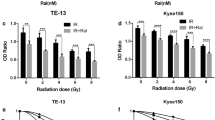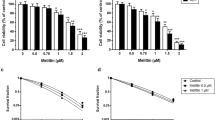Abstract
Currently, unresectable esophageal squamous cell carcinoma (ESCC) is primarily treated by chemoradiotherapy. However, the outcome has not improved significantly because of radioresistance of cancer cells. This study aimed to determine the radiosensitizing effect of melittin, a novel component of bee venom, in ESCC. ESCC cell lines were irradiated with or without melittin. Cell proliferation was detected by Cell Counting Kit 8 assay. Radiosensitization was evaluated by clonogenic survival assay. Cell apoptosis was detected by flow cytometry. Results show that melittin potently sensitized ESCC cells to radiation with a sensitization enhancement ratio of 1.15–1.42. Radiosensitization was accompanied with enhanced apoptosis and regulated by apoptosis proteins. The results were confirmed by in vivo studies on tumor-bearing xenografts. In summary, these results provide support that melittin may be a potentially promising radiosensitizer in ESCC radiation therapy.







Similar content being viewed by others
Reference
Jemal A, Bray F, Center MM, et al. Global cancer statistics. CA Cancer J Clin. 2011;61:69–90.
Chen W, Zheng R, Zhang S, et al. Annual report on status of cancer in China, 2010. Chin J Cancer Res. 2014;26:48–58.
Chen W, He Y, Zheng R, et al. Esophageal cancer incidence and mortality in China, 2009. J Thorac Dis. 2013;5:19–26.
Shoji M, Ninomiya I, Makino I, et al. Valproic acid, a histone deacetylase inhibitor, enhances radiosensitivity in esophageal squamous cell carcinoma. Int J Oncol. 2012;40:2140–6.
Huang C, Jin H, Qian Y, et al. Hybrid melittin cytolytic Peptide-driven ultrasmall lipid nanoparticles block melanoma growth in vivo. ACS Nano. 2013;7:5791–800.
Wooddell CI, Rozema DB, Hossbach M, et al. Hepatocyte-targeted RNAi therapeutics for the treatment of chronic hepatitis B virus infection. Mol Ther. 2013;21:973–85.
Liu H, Han Y, Fu H, et al. Construction and expression of sTRAIL-melittin combining enhanced anticancer activity with antibacterial activity in Escherichia coli. Appl Microbiol Biotechnol. 2013;97:877–2884.
Park JH, Kim KH, Lee WR, et al. Protective effect of melittin on inflammation and apoptosis in acute liver failure. Apoptosis. 2012;17:61–9.
Liu M, Zong J, Liu Z, et al. A novel melittin-MhIL-2 fusion protein inhibits the growth of human ovarian cancer SKOV3 cells in vitro and in vivo tumor growth. Cancer Immunol Immunother. 2013;62:889–95.
Rim DS, Altschuld RA, Ganote CE. Effects of calcium depletion and loading on injury during metabolic inhibition of isolated adult rat myocytes. J Mol Cell Cardiol. 1990;22:227–37.
Jo M, Park MH, Kollipara PS, et al. Anti-cancer effect of bee venom toxin and melittin in ovarian cancer cells through induction of death receptors and inhibition of JAK2/STAT3 pathway. Toxicol Appl Pharmacol. 2012;258:72–81.
Muller UR. Hymenoptera venom proteins and peptides for diagnosis and treatment of venom allergic patients. Inflamm Allergy Drug Targets. 2011;10:420–8.
Saugar JM, Rodriguez-Hernandez MJ, de la Torre BG, et al. Activity of cecropin A-melittin hybrid peptides against colistin-resistant clinical strains of Acinetobacter baumannii: molecular basis for the differential mechanisms of action. Antimicrob Agents Chemother. 2006;50:1251–6.
Binder M, Fierlbeck G, King T, et al. Individual hymenoptera venom compounds induce upregulation of the basophil activation marker ectonucleotide pyrophosphatase/phosphodiesterase 3 (CD203c) in sensitized patients. Int Arch Allergy Immunol. 2002;129:160–8.
Jeong YJ, Choi Y, Shin JM et al. Melittin suppresses EGF-induced cell motility and invasion by inhibiting PI3K/Akt/mTOR signaling pathway in breast cancer cells. Food Chem Toxicol 2014.
Gajski G, Garaj-Vrhovac V. Melittin: a lytic peptide with anticancer properties. Environ Toxicol Pharmacol. 2013;36:697–705.
Glinka EM. Eukaryotic expression vectors bearing genes encoding cytotoxic proteins for cancer gene therapy. Plasmid. 2012;68:69–85.
Park MH, Choi MS, Kwak DH, et al. Anti-cancer effect of bee venom in prostate cancer cells through activation of caspase pathway via inactivation of NF-kappaB. Prostate. 2011;71:801–12.
Zhang HP, Takayama K, Su B, et al. Effect of sunitinib combined with ionizing radiation on endothelial cells. J Radiat Res. 2011;52:1–8.
Efimova EV, Liang H, Pitroda SP, et al. Radioresistance of Stat1 over-expressing tumour cells is associated with suppressed apoptotic response to cytotoxic agents and increased IL6-IL8 signalling. Int J Radiat Biol. 2009;85:421–31.
Wang C, Chen T, Zhang N, et al. Melittin, a major component of bee venom, sensitizes human hepatocellular carcinoma cells to tumor necrosis factor-related apoptosis-inducing ligand (TRAIL)-induced apoptosis by activating CaMKII-TAK1-JNK/p38 and inhibiting IkappaBalpha kinase-NFkappaB. J Biol Chem. 2009;284:3804–13.
Kim SJ, Park JH, Kim KH, et al. Melittin inhibits atherosclerosis in LPS/high-fat treated mice through atheroprotective actions. J Atheroscler Thromb. 2011;18:1117–26.
Kim SK, Park KY, Yoon WC, et al. Melittin enhances apoptosis through suppression of IL-6/sIL-6R complex-induced NF-kappaB and STAT3 activation and Bcl-2 expression for human fibroblast-like synoviocytes in rheumatoid arthritis. Joint Bone Spine. 2011;78:471–7.
Ezekwudo D, Shashidharamurthy R, Devineni D, et al. Inhibition of expression of anti-apoptotic protein Bcl-2 and induction of cell death in radioresistant human prostate adenocarcinoma cell line (PC-3) by methyl jasmonate. Cancer Lett. 2008;270:277–85.
Basu A, Haldar S. The relationship between BcI2, Bax and p53: consequences for cell cycle progression and cell death. Mol Hum Reprod. 1998;4:1099–109.
Jiang H, Zhao PJ, Su D et al. Paris saponin I induces apoptosis via increasing the Bax/Bcl2 ratio and caspase3 expression in gefitinibresistant nonsmall cell lung cancer in vitro and in vivo. Mol Med Rep 2014.
Acknowledgments
This work was supported by the Natural Science Foundation of China (no. 81272504), Research and Innovation Project for College Graduates of Jiangsu Province (no. CXZZ12_0588), Innovation Team (no. LJ201123 (EH11)), A Project Funded by the Priority Academic Program Development of Jiangsu Higher Education Institutions (PAPD; JX10231801), grants from Key Academic Discipline of Jiangsu Province “Medical Aspects of Specific Environments,” Six Major Talent Peak Project of Jiangsu Province (2013-WSN-040), Jiangsu Provincial Science and Technology Projects (BK2011854 (DA11)), and “333” Project of Jiangsu Province (BRA2012210 (RS12)).
Conflicts of interest
None
Author information
Authors and Affiliations
Corresponding author
Additional information
Hongcheng Zhu, Xi Yang, and Jia Liu contributed equally to this work.
Rights and permissions
About this article
Cite this article
Zhu, H., Yang, X., Liu, J. et al. Melittin radiosensitizes esophageal squamous cell carcinoma with induction of apoptosis in vitro and in vivo. Tumor Biol. 35, 8699–8705 (2014). https://doi.org/10.1007/s13277-014-2146-z
Received:
Accepted:
Published:
Issue Date:
DOI: https://doi.org/10.1007/s13277-014-2146-z




